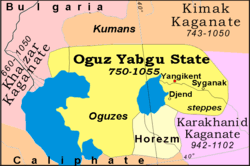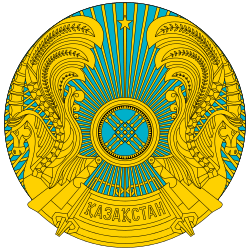Oghuz Yabgu State
| Oghuz Yabgu State | ||||||||||||
| Kaganate | ||||||||||||
| ||||||||||||
 Oguz Yabgu State in Kazakhstan, 750–1055 | ||||||||||||
| Capital | Yangikent | |||||||||||
| Languages | Turkic | |||||||||||
| Religion | Tengriism | |||||||||||
| Political structure | Kaganate | |||||||||||
| Historical era | 8th–11th centuries | |||||||||||
| • | Established | 750 | ||||||||||
| • | Disestablished | 1055 | ||||||||||
| ||||||||||||
Part of a series on the |
||||||||||||||||||||
|---|---|---|---|---|---|---|---|---|---|---|---|---|---|---|---|---|---|---|---|---|
| History of Kazakhstan | ||||||||||||||||||||
 | ||||||||||||||||||||
| Ancient | ||||||||||||||||||||
|
||||||||||||||||||||
| Khanates | ||||||||||||||||||||
|
||||||||||||||||||||
| Colonization and post-nomadic period | ||||||||||||||||||||
|
||||||||||||||||||||
| Republic of Kazakhstan | ||||||||||||||||||||
|
||||||||||||||||||||
| Topics | ||||||||||||||||||||
|
| ||||||||||||||||||||
The Oguz Yabgu State (Oguz il, meaning Oguz Land, Oguz Country, 750–1055) was a Turkic state, founded by Oguz Turks in 766, located geographically in an area between the coasts of the Caspian and Aral Seas. Oguz tribes occupied a vast territory in Kazakhstan along the Irgiz, Yaik, Emba, and Uil rivers, the Aral Sea area, the Syr Darya valley, the foothills of the Karatau Mountains in Tien-Shan, and the Chui River valley (see map). The Oguz political association developed in the 9th and 10th centuries in the basin of the middle and lower course of the Syr Darya and adjoining the modern western Kazakhstan steppes.
Etymology
The etymology of the name "Oguz" is unclear. It was discussed many times in historical and philological literature. The term probably means "tribes", or the "tribal union", and then could turn into a collective ethnic name. The original Oguz areas were the south-eastern regions of Central Asia. The beginning of the early Oguz group formation is linked to the Western Zhetysu (often known, in Russian and other European languages, as Semirechye).
History
Early history
The first reference of the Oguz State is by the Arab geographer Yaqubi, who called Oguzes "kings". In Zhetysu the old Oguz capital was Guziya. The Chinese sources that ascend to the 7th and 8th centuries state that the Oguz confederation Tokuz Oguz (Chinese Gu-su, Кut for Oguz) is consistently shown in the vicinity of Issyk Kul – Talas,[4] from the Issyk Kul area the center of the Oguz confederation shifted to the lower course of the Syr Darya under pressure of the refugees of the Sary Turgesh tribe.[5][6]
In 766, after Karluks overran the Turgesh Kaganate in Zhetysu (southeastern modern Kazakhstan), Karluk tribes formed a Khanate centered there under the rule of a Yabgu, and they occupied and transferred their capital to Suyab. By that time the bulk of the Uch-Karluk (Three Karluks) confederation had left the Altai, and the supremacy in Zhetysu passed to the Karluk tribes. After the Oguz confederation lost a struggle with the Karluks for leadership in the Turgesh Kaganate, a significant part of Zhetysu Oguzes migrated to the Karatau Mountains foothills and the valley of the Chu River in the Issyk Kul basin.
At the beginning of the 9th century the Oguz confederation, in alliance with Karluks and Kimaks destroyed the Kangar Union and captured the lower course of the Syr Darya river and the Aral steppes, displacing the Kangars and Pechenegs. The nomadic tribes of the Syr Darya Kangars were forced to join the Oguzes, and a part of them migrated to the west to the northern Black Sea region. The Oguzes moved their capital to Yangikent and became known as Oguz Yabgu State.
The state was founded in Eni-Kent which was an Oguz yayla (summer village). Oguz il extended from "Issyk Kul and Almalyk, in the south, to Sairam, in the west, to the city of Yangikent, which stands at the mouth of the river Syr (Syr-darya), and to the Kara-Kum (desert)".[7] The capital of the Oguz il was variously spelled Eni-Kent, Yangikent, Djanikand, Yenikent, Yanikand, all meaning New City, and also in Arabic literature al-Kariya al-Hadisa and in Persian literature Deh-i Hay; presently it is a Central Asian ghost town Jankent.
The state was ruled by the leader of the Oguz Turks with the title Yabgu, which is similar to other Turkic ruling titles such as Khan and Kagan/Hakan, but initially with a status below Kagan/Hakan. The army was commanded by Subaşı. "Sü" (su) means "Army" in Turkish and "başı" (bashi) means "the head of" or "the ruler of".
Political history
The Oguz State played an important role in the military and political history of Eurasia.
In 965 the Oguz State allied with Kievan Rus in a war against the Khazar Kaganate. In 985 the alliance with Kievan Rus defeated Volga Bulgaria, which increased the political power of the Oguz State.
At the turn of the 10th–11th centuries, popular uprisings broke out against excessive taxation in the state. The revolts became especially strong in the second half of the 10th century, during the rule of Ali Yabgu. The split between the ruling Oguzes and Seljuk branch of Oguzes turned out to be detrimental to the state. The upheaval was used by the Seljuk branch, who led an uprising and took Jend, but soon they were forced to leave the Jend area.
During the reign of the last Oguz Yabgu Shahmalik the state rebounded. In 1041 Shahmalik Yabgu conquered Khorezm from the Ghaznavids, but two years later he was captured by the Seljuk forces and executed. Shahmalik Yabgu was the last ruler of the Oguz State.
Internal turmoil and conflict with the Seljuks weakened the Oguz State. The weakened state fell under attacks by the Kipchak tribes from the Kimak Kaganate. Under the pressure of the Kipchaks, the two branches of the Oguz people split, a significant part of the Oguzes went to Eastern Europe, and the Seljuk Oguzes left toward Asia Minor. Another part of the Oguzes fell under the rule of the Karahanids and Seljuk rulers of Khorasan. The remnants of those Oghuz defeated by the Kipchaks subsequently dissolved among the Turkic-speaking tribes of Dasht-e-Kipchak. The Oghuz tribes contributed to the formation of many of today's Turkic peoples.
In the 11th century, Oguz migration to Persia and the Near East began. The movement was led by the head of the Kanyk tribe Togrul bek and Chagry bek, the grandchildren of Seljuk. This migrating group became, in time, the Seljuk Empire. In 1025 a part of the Seljuks settled in the territory of the modern Turkmenistan, centered on the city of Nysa. In 1034 – 1035, they were joined by Togrul bek's subjects. In 1038–1040, the Seljuks fought against Ghaznavids and captured Nishapur. Subsequently, they were able to create a huge state, which consisted of Asia Minor, Persia, and parts of the Caucasus and Central Asia.
The Oguz il state existed for three centuries. Another Turkic group, Kipchaks and Kimeks of the Kimek Kaganate, ended the state by the 12th century. By that time, Selçuk Bey and his Kınık (tribe) headed to Persia to found their own Muslim state, which in the future would become the Great Seljuq Empire, and a part of the state population moved eastward to the N.Pontic areas.
Political system
The economic base of society was private ownership of livestock. Little is known about the old farming communities in the oases, river valleys, and wetlands. The cities continued to be populated by traders and artisans.
The title of the elected ruler was Yabgu. The power was hereditary within a ruling clan. The heir to the throne was called Inal, they were brought up by an Atabek tutor. Elections of Yabgu were conducted at the tribal assemblies. The rulers were chosen by the codex of unwritten rules of customary law – "tore", from the most powerful clans. The power of the supreme ruler was limited by the council of largest military-tribal aristocracy. The wives of the rulers bore a title "Khatun" and played a significant role in the court life. Yabgu was assisted by regional rules titled Kul-Eerkins. An important place was occupied by warlords. A head of the army was called Subashi, from su – army and bash – head. The Subashi was supported by a military council, and actively interfered in political events.
The Oguz States was subdivided into uruks and aimaks. The term uruk designated tribal divisions, aimak was an administrative district. The clans and tribes united into larger tribal alliances were known as il (country). By the end of the 10th century formed a formal administrative apparatus and a system of regular taxes.
The main religion was the traditional Tengrism, and later Islam.
Ethnic composition
The powerbase of the Oguz State were semi-nomadic and nomadic tribes of Zhetysu and Siberia: Khalaj, Uigurs, Djagra, Charuk, Karluk, Imura, Bayandur, Kai, and the remaining tribes and sedentary population of the Kangar Union that submitted to the Oguz Yabgu. The Oguz State was heterogeneous in ethnic terms. In urban and rural areas lived Turkic and Horezmian-speaking population. The reformation of the Oguz ethnic community was a complex and lengthy process.
According to the Mahmud Kashgari (11th century) testimony, Oguz confederation consisted of 24 tribes, of which 12 tribes were Buzuks or Bazouk (Turkish: Bozoklar - Grey Arrows), and 12 tribes were Uchuks (Turkish: Üçoklar - Three Arrows). The Buzuk wing had a privileged status. Later authors, notably Marvazi, describe only about 12 tribes. The discrepancy between the sources probably resulted from the Oguz division into two exogamous parts, Buzuks and Uchuks belonging respectively to the right and the left wing of their army. Oguz States share in the Uruk and aimags. The term "Uruk" designated tribal divisions. Clans and tribes, united into larger tribal alliances known as "il" (the country).
References
- Kusainova M.A., 2006, History of Kazakhstan, Shyn Kіtap, ISBN 9965-9784-4-1 (Кусаинова М.А., 2006, История Казахстана, Шың Кітап) in Russian
- ↑ Marshall Cavendish Corporation (2006). Peoples of Western Asia. p. 364.
- ↑ Bosworth, Clifford Edmund (2007). Historic Cities of the Islamic World. p. 280.
- ↑ Borrero, Mauricio (2009). Russia: A Reference Guide from the Renaissance to the Present. p. 162.
- ↑ Zuev Yu.A., Horse Tamgas from Vassal Princedoms (Translation of Chinese composition "Tanghuyao" of 8th–10th centuries), Kazakh SSR Academy of Sciences, Alma-Ata, I960, p. 133 (In Russian)
- ↑ Bartold W.W., "Sketch of the Jeti-su history", Frunze, 1943, pp. 20–21
- ↑ "In the 8th century, Oguzes were already on Syr-darya outside of the ten arrows Türkic Kaganate (Western Turkic Kaganate)". Zuev Yu.A., Horse Tamgas from Vassal Princedoms, p. 134
- ↑ Kononov A.N., Genealogy of Turkmens, Moskow-Leningrad, USSR Academy of Sciences, 1958, p. 81 (Кононов А.Н., Родословная туркмен. Сочинение Абу-л-гази, хана хивинского, Москва-Ленинград, АН СССР, 1958) (In Russian)
| Preceded by Jeti-su Oguz confederation |
Oguz Il state 8 c. – 12 c. |
Succeeded by Seljuq Empire |